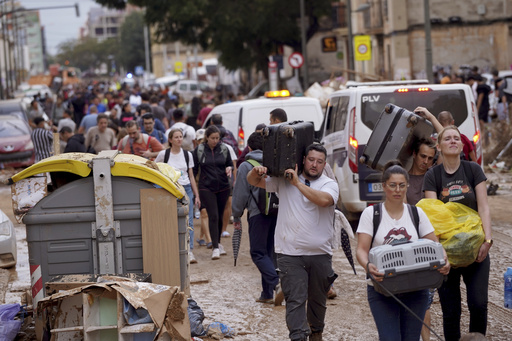
MADRID — On Tuesday, eastern Spain experienced devastating flash floods resulting from intense rainfall, affecting numerous communities in a matter of minutes. Many individuals found themselves trapped in their vehicles, homes, or businesses with little chance to respond. Tragically, the extreme weather has resulted in loss of life, leaving many families grief-stricken and communities reeling from the destruction of their livelihoods.
As of two days after the catastrophic event, rescue teams have discovered 158 deceased individuals, with 155 bodies recovered from the Valencia region alone. Additionally, two were found in Castilla La Mancha and one in Andalusia, while the search continues for numerous people still unaccounted for. As the cleanup begins, residents continue to grapple with significant disruptions, including power outages, water shortages, and a scarcity of essential supplies. Many vehicles inundated by the floodwaters remain piled or crashed into buildings, with some still containing unrecognized victims.
Here are some critical details regarding Spain’s most lethal storm in recent recollection:
**What transpired?**
The storms predominantly affected the river basins of the Magro and Turia, causing sudden torrents of water that overflowed their banks. This swift surge caught many residents off guard while they were engaged in their daily activities, with numerous individuals returning home from work in the evening when disaster struck.
In an instant, muddy waters inundated roads, railways, and homes within the southern outskirts of Valencia city. Some drivers had to seek shelter on the roofs of their vehicles, while others aimed to find safety on elevated grounds. Spain’s national weather service reported extraordinary rainfall, indicating that the town of Chiva received more precipitation in eight hours than it had in the previous 20 months.
Although authorities issued emergency alerts on mobile devices to warn citizens and advise them to stay indoors, many were already on the road or caught in low-lying areas, where garages became deadly traps due to the rising waters.
**What caused the severe flash floods?**
Experts attribute the floods to two significant factors related to human-induced climate change. First, warmer air retains more moisture, leading to heavier rainfall. Second, shifts in the jet stream, which directs weather patterns globally, can result in severe weather events. Meteorologists noted that an unusual low-pressure storm system, known locally as a DANA, became stationary over the area, unleashing relentless rain.
Additionally, the Mediterranean Sea had experienced its hottest surface temperature on record in mid-August, reaching 28.47 degrees Celsius (83.25 degrees Fahrenheit), contributing to the impact of these storms. This extreme weather event followed a prolonged drought in Spain during 2022 and 2023, emphasizing the worsening cycles of drought and flood attributed to climate change.
**Has Spain experienced similar events in the past?**
The Mediterranean coast is accustomed to autumn storms that can lead to flooding; however, this recent incident stands out as the most powerful flash flood occurrence in memory. Residents in the town of Paiporta, which bore the brunt of the disaster, have claimed the inundation was three times worse than the catastrophic floods of 1957, which resulted in a minimum of 81 casualties and marked the worst flooding event in the region’s history. That episode prompted changes to the Turia river’s course, ultimately protecting much of the city from flooding in the future.
Valencia also faced other significant DANAs in the 1980s, one in 1982 that claimed roughly 30 lives and another in 1987 that broke various rainfall records. The current flash floods are now recorded as Spain’s deadliest natural disaster in recent history, surpassing the Biescas camping site tragedy in August 1996 that resulted in 87 fatalities.
